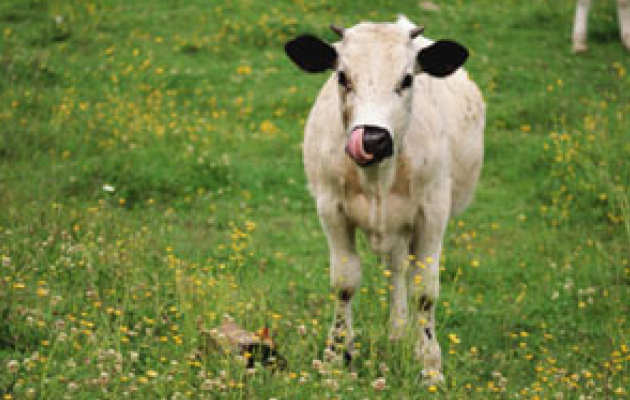Modelling of the agricultural sector: ammonia emissions and the nitrogen cycle
 The agricultural sector is responsible for most of the ammonia emitted into the atmosphere, arising particularly from livestock wastes and when urea is used as a fertilizer. These ammonia emissions contribute a growing proportion of nitrogen deposition across Europe as emissions of nitrogen dioxide are controlled, and hence are receiving increased emphasis to reduce impacts of acidification and eutrophication (excess nitrogen) on sensitive ecosystems. Eutrophication threatens plant species able to thrive with low nitrogen availability, and is responsible for such changes as replacement of heathland by coarse grass. Ammonia also reacts with acidic species in the atmosphere contributing to fine particulate matter and possible health effects.
The agricultural sector is responsible for most of the ammonia emitted into the atmosphere, arising particularly from livestock wastes and when urea is used as a fertilizer. These ammonia emissions contribute a growing proportion of nitrogen deposition across Europe as emissions of nitrogen dioxide are controlled, and hence are receiving increased emphasis to reduce impacts of acidification and eutrophication (excess nitrogen) on sensitive ecosystems. Eutrophication threatens plant species able to thrive with low nitrogen availability, and is responsible for such changes as replacement of heathland by coarse grass. Ammonia also reacts with acidic species in the atmosphere contributing to fine particulate matter and possible health effects.
During development of the Gothenburg protocol under the UN ECE Convention on Long-Range Transboundary Air Pollution, the IAU at Imperial College undertook the MARACCAS project on the potential for emission reduction with different agricultural practices across Europe: since at that time experience in this area was limited to relatively few countries such as the Netherlands. This has been followed by more detailed work on control of NH3 emissions from livestock farming in the UK, including the NARSES project, led by ADAS. This covers control of emissions generated from animal housing, storage of wastes, and spreading on the land, and can now be used in the UKIAM model in investigating cost-effective strategies to achieve compliance with EC and international legislation while also improving environmental protection in the UK. Since ammonia emissions can lead to substantial local deposition near the source, as well as direct effects of exposure to gaseous NH3, the IAU is also collaborating with UKCEH Edinburgh in considering how local measures can be effective in protecting ecosystem areas of special value such as Special Areas of Conservations (SACs) and Special Protection Areas (SPAs).
There is now international recognition of the need to address the whole nitrogen cycle which is being boosted by the increasing use of fertilizers worldwide, including the generation of N2O as a potent greenhouse gas, and water related problems of nitrate leaching as well as ammonia emissions. Agriculture is also a major source of another greenhouse gas, methane, CH4. Thus, an integrated approach to nitrogen and the agricultural sector is required since measures to help one problem can affect another. Future projections for agricultural activities and land-use, affected by the introduction of new Environmental Land Management schemes to replace the Common Agriculture Policy (CAP) following Brexit, and other influences on farming, are also important in considering compliance with potential emission ceilings in 2020 and beyond.
Land use, land use change and forestry (LULUCF)
Agriculture and land use in the UK is entering a period of high uncertainty and potentially transformational change as each of the UK’s regions transition away from the CAP payment system. In England this will be replaced by the Environmental Land Management (ELM) schemes, and in Wales by the Sustainable Farming Scheme (SFS), while Scotland and Northern Ireland are also planning similar initiatives. These schemes are designed to incentivise farmers and landowners to adopt sustainable practices, restore or create priority habitat areas and to deliver a wide range of environmental benefits. The degree to which these schemes can deliver on the UK’s net zero and wider environmental targets will depend on a myriad of complex, interdependent factors. These include socio-economic factors which will dictate the uptake rate of these schemes by farmers, in addition to new developments in science leading to improved guidance on best practice and more accurate estimates of the environmental impact of these changes, e.g. on the rate of carbon sequestration from newly planted woodland or the reduction in greenhouse gas emissions as a result of restoring peatland. Another factor is dietary change, with reductions of meat and dairy production.
LULUCF is a key sector for achieving our net zero targets as it is the carbon sequestered by this sector which will allow net zero to be achieved without fully decarbonising other particularly challenging sectors, such as aviation. LULUCF is also closely linked to agriculture as a key sector impacting on air quality, water quality and biodiversity loss. We are particularly concerned with the impact of NH3 emissions on nitrogen-sensitive habitats through eutrophication.

We also recognise the vital need to better understand the range of alternative futures that are possible for UK land use and agriculture in order to help policy makers devise a strategy that maximises the benefit to society and the environment. We are therefore developing spatially explicit future scenarios for UK land use and agriculture, drawing on the Climate Change Committee’s (CCC) recommended pathways to net zero. Only by spatially mapping these future scenarios can we make a full evaluation of their feasibility and assess what land use change is most appropriate at any given location.
For staff
If you are a new CEP staff member and would like to be included on the research webpages, or would like to amend your existing details, please submit this form (login required- only works for members of CEP).